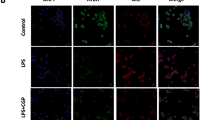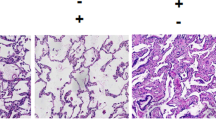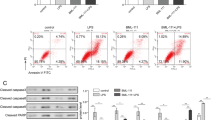Abstract
Acute respiratory distress syndrome (ARDS) is a devastating respiratory disorder, characterized by overwhelming inflammation in the alveoli without effective pharmacological treatment. We aimed to investigate the effect and mechanism of angiotensin II type 2 receptor (AT2R) agonist, Compound 21 (C21), on the lipopolysaccharide (LPS)-induced acute lung injury (ALI) model. The protective effect of C21 was evaluated via enzyme-linked immunosorbent assay (ELISA), Western blot (WB), real-time PCR, and fluorescence microscopy in LPS-challenged THP1-derived macrophages. Besides, the in vivo efficacy of C21 was assessed using cell counting, ELISA, protein quantification, hematoxylin–eosin (H&E) staining, and WB in an LPS-induced ALI mouse model. The results showed that C21 significantly inhibited the secretion of pro-inflammatory cytokines (CCL-2, IL-6), overproduction of intracellular ROS, and activation of inflammatory pathways (NF-κB/NLRP3, p38/MAPK) in THP-1 cell-derived macrophages stimulated by LPS. In in vivo study, intraperitoneal injection of C21 could reduce airway leukocytes accumulation and chemokine/cytokine (keratinocyte chemoattractant (KC), IL-6) generation, as well as alleviate diffuse alveolar damage induced by LPS. Conclusively, the AT2R agonist C21 significantly inhibited LPS-stimulated excess inflammatory responses and oxidative stress in macrophages. Meanwhile, C21 could effectively alleviate acute inflammation and tissue damage in the lungs of ALI mice challenged by LPS. The results of this study bring new hope for the early treatment of ALI/ARDS.





Similar content being viewed by others
Data availability
The data that support the findings of this study are available from the corresponding author upon reasonable request.
References
Bhat SA, Fatima Z, Sood A, Shukla R, Hanif K (2021) The protective effects of AT2R agonist, CGP42112A, against angiotensin II-induced oxidative stress and inflammatory response in astrocytes: role of AT2R/PP2A/NFkappaB/ROS signaling. Neurotox Res 39(6):1991–2006. https://doi.org/10.1007/s12640-021-00403-4
Cantero-Navarro E, Fernandez-Fernandez B, Ramos AM, Rayego-Mateos S, Rodrigues-Diez RR, Sanchez-Nino MD, Sanz AB, Ruiz-Ortega M, Ortiz A (2021) Renin-angiotensin system and inflammation update. Mol Cell Endocrinol 529:111254. https://doi.org/10.1016/j.mce.2021.111254
Chow BS, Allen TJ (2016) Angiotensin II type 2 receptor (AT2R) in renal and cardiovascular disease. Clin Sci (Lond) 130(15):1307–1326. https://doi.org/10.1042/CS20160243
Dandona P, Dhindsa S, Ghanim H, Chaudhuri A (2007) Angiotensin II and inflammation: the effect of angiotensin-converting enzyme inhibition and angiotensin II receptor blockade. J Hum Hypertens 21(1):20–27. https://doi.org/10.1038/sj.jhh.1002101
Danyel LA, Schmerler P, Paulis L, Unger T, Steckelings UM (2013) Impact of AT2-receptor stimulation on vascular biology, kidney function, and blood pressure. Integr Blood Press Control 6:153–161. https://doi.org/10.2147/IBPC.S34425
Dhande I, Ma W, Hussain T (2015) Angiotensin AT2 receptor stimulation is anti-inflammatory in lipopolysaccharide-activated THP-1 macrophages via increased interleukin-10 production. Hypertens Res 38(1):21–29. https://doi.org/10.1038/hr.2014.132
Du Y, Tu L, Zhu P, Mu M, Wang R, Yang P, Wang X, Hu C, ** R, Hu P, Li T, Cao F, Chang C, Hu Q, ** Y, Xu G (2020) Clinical features of 85 fatal cases of COVID-19 from Wuhan. A retrospective observational study. Am J Respir Crit Care Med 201(11):1372–1379. https://doi.org/10.1164/rccm.202003-0543OC
El-Arif G, Khazaal S, Farhat A, Harb J, Annweiler C, Wu Y, Cao Z, Kovacic H, Abi Khattar Z, Fajloun Z, Sabatier JM (2022). Angiotensin II type I receptor (AT1R): the gate towards COVID-19-associated diseases. Molecules 27(7). https://doi.org/10.3390/molecules27072048
Fan E, Brodie D, Slutsky AS (2018) Acute respiratory distress syndrome: advances in diagnosis and treatment. JAMA 319(7):698–710. https://doi.org/10.1001/jama.2017.21907
Fatima N, Patel S, Hussain T (2021) Angiotensin AT2 receptor is anti-inflammatory and reno-protective in lipopolysaccharide mice model: role of IL-10. Front Pharmacol 12:600163. https://doi.org/10.3389/fphar.2021.600163
Gao YL, Du Y, Zhang C, Cheng C, Yang HY, ** YF, Duan GC, Chen SY (2020) Role of renin-angiotensin system in acute lung injury caused by viral infection. Infect Drug Resist 13:3715–3725. https://doi.org/10.2147/IDR.S265718
Huang X, **u H, Zhang S, Zhang G (2018) The role of macrophages in the pathogenesis of ALI/ARDS. Mediators Inflamm 2018:1264913. https://doi.org/10.1155/2018/1264913
Huang C, Wang Y, Li X, Ren L, Zhao J, Hu Y, Zhang L, Fan G, Xu J, Gu X, Cheng Z, Yu T, **a J, Wei Y, Wu W, **e X, Yin W, Li H, Liu M, **ao Y, Gao H, Guo L, **e J, Wang G, Jiang R, Gao Z, ** Q, Wang J, Cao B (2020) Clinical features of patients infected with 2019 novel coronavirus in Wuhan, China. Lancet 395(10223):497–506. https://doi.org/10.1016/S0140-6736(20)30183-5
Imai Y, Kuba K, Rao S, Huan Y, Guo F, Guan B, Yang P, Sarao R, Wada T, Leong-Poi H, Crackower MA, Fukamizu A, Hui CC, Hein L, Uhlig S, Slutsky AS, Jiang C, Penninger JM (2005) Angiotensin-converting enzyme 2 protects from severe acute lung failure. Nature 436(7047):112–116. https://doi.org/10.1038/nature03712
Matute-Bello G, Downey G, Moore BB, Groshong SD, Matthay MA, Slutsky AS, Kuebler WM, G. Acute Lung Injury in Animals Study (2011) An official American Thoracic Society workshop report: features and measurements of experimental acute lung injury in animals. Am J Respir Cell Mol Biol 44(5):725–738. https://doi.org/10.1165/rcmb.2009-0210ST
Mei SH, McCarter SD, Deng Y, Parker CH, Liles WC, Stewart DJ (2007) Prevention of LPS-induced acute lung injury in mice by mesenchymal stem cells overexpressing angiopoietin 1. PLoS Med 4(9):e269. https://doi.org/10.1371/journal.pmed.0040269
Menk M, Graw JA, von Haefen C, Steinkraus H, Lachmann B, Spies CD, Schwaiberger D (2018) Angiotensin II type 2 receptor agonist Compound 21 attenuates pulmonary inflammation in a model of acute lung injury. J Inflamm Res 11:169–178. https://doi.org/10.2147/JIR.S160573
Mishra JS, Kumar S (2021) Activation of angiotensin type 2 receptor attenuates testosterone-induced hypertension and uterine vascular resistance in pregnant rats. Biol Reprod 105(1):192–203. https://doi.org/10.1093/biolre/ioab051
Orte C, Polak JM, Haworth SG, Yacoub MH, Morrell NW (2000) Expression of pulmonary vascular angiotensin-converting enzyme in primary and secondary plexiform pulmonary hypertension. J Pathol 192(3):379–384. https://doi.org/10.1002/1096-9896(2000)9999:9999%3c::AID-PATH715%3e3.0.CO;2-Q
Otsuka M, Takahashi H, Shiratori M, Chiba H, Abe S (2004) Reduction of bleomycin induced lung fibrosis by candesartan cilexetil, an angiotensin II type 1 receptor antagonist. Thorax 59(1):31–38. https://doi.org/10.1136/thx.2003.000893
Sarzani R, Giulietti F, Di Pentima C, Giordano P, Spannella F (2020) Disequilibrium between the classic renin-angiotensin system and its opposing arm in SARS-CoV-2-related lung injury. Am J Physiol Lung Cell Mol Physiol 319(2):L325–L336. https://doi.org/10.1152/ajplung.00189.2020
Sumners C, Peluso AA, Haugaard AH, Bertelsen JB, Steckelings UM (2019) Anti-fibrotic mechanisms of angiotensin AT(2) -receptor stimulation. Acta Physiol (Oxf) 227(1):e13280. https://doi.org/10.1111/apha.13280
Thompson BT, Chambers RC, Liu KD (2017) Acute respiratory distress syndrome. N Engl J Med 377(6):562–572. https://doi.org/10.1056/NEJMra1608077
Tornling G, Batta R, Porter JC, Williams B, Bengtsson T, Parmar K, Kashiva R, Hallberg A, Cohrt AK, Westergaard K, Dalsgaard CJ, Raud J (2021) Seven days treatment with the angiotensin II type 2 receptor agonist C21 in hospitalized COVID-19 patients; a placebo-controlled randomised multi-centre double-blind phase 2 trial. EClinicalMedicine 41:101152. https://doi.org/10.1016/j.eclinm.2021.101152
Wan Y, Wallinder C, Plouffe B, Beaudry H, Mahalingam AK, Wu X, Johansson B, Holm M, Botoros M, Karlen A, Pettersson A, Nyberg F, Fandriks L, Gallo-Payet N, Hallberg A, Alterman M (2004) Design, synthesis, and biological evaluation of the first selective nonpeptide AT2 receptor agonist. J Med Chem 47(24):5995–6008. https://doi.org/10.1021/jm049715t
Zhang H, Sun GY (2005) LPS induces permeability injury in lung microvascular endothelium via AT(1) receptor. Arch Biochem Biophys 441(1):75–83. https://doi.org/10.1016/j.abb.2005.06.022
Zhou F, Yu T, Du R, Fan G, Liu Y, Liu Z, **ang J, Wang Y, Song B, Gu X, Guan L, Wei Y, Li H, Wu X, Xu J, Tu S, Zhang Y, Chen H, Cao B (2020) Clinical course and risk factors for mortality of adult inpatients with COVID-19 in Wuhan, China: a retrospective cohort study. Lancet 395(10229):1054–1062. https://doi.org/10.1016/S0140-6736(20)30566-3
Funding
This work was supported by the National Natural Science Foundation of China (grant number: 82000086), Shanghai Sailing Program (grant number: 20YF1440300) for Wei Gao.
Author information
Authors and Affiliations
Contributions
QL is responsible for the study. LC, PG, YS, LM, and MW coordinated to conduct experiments with the guidance from WG and QL. LC, PG, and YS wrote and revised the manuscript. All authors read and approved the final manuscript. The authors declare that all data were generated in-house and that no paper mill was used.
Corresponding authors
Ethics declarations
Ethics approval
All animal procedures were approved by the Management and Ethics Committee of the Laboratory Animal Research Center of Tongji University (Permit Number: TJBB03721106). All procedures on mice were performed under anesthesia, and all efforts were made to minimize the animal suffering.
Consent for publication
All co-authors have approved the manuscript and agreed with the publication.
Conflict of interest
The authors declare no competing interests.
Additional information
Publisher's note
Springer Nature remains neutral with regard to jurisdictional claims in published maps and institutional affiliations.
Rights and permissions
Springer Nature or its licensor (e.g. a society or other partner) holds exclusive rights to this article under a publishing agreement with the author(s) or other rightsholder(s); author self-archiving of the accepted manuscript version of this article is solely governed by the terms of such publishing agreement and applicable law.
About this article
Cite this article
Chen, L., Gong, P., Su, Y. et al. Angiotensin II type 2 receptor agonist attenuates LPS-induced acute lung injury through modulating THP-1-derived macrophage reprogramming. Naunyn-Schmiedeberg's Arch Pharmacol 397, 99–108 (2024). https://doi.org/10.1007/s00210-023-02589-0
Received:
Accepted:
Published:
Issue Date:
DOI: https://doi.org/10.1007/s00210-023-02589-0




